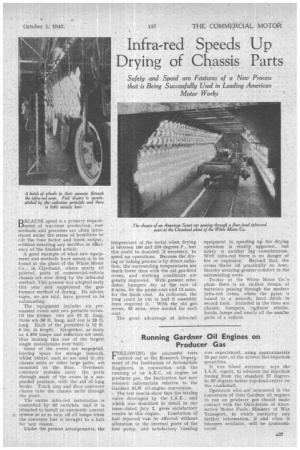Infra-red Speeds Up
Page 29

If you've noticed an error in this article please click here to report it so we can fix it.
Drying of Chassis Parts
Safety and Speed _are Features of a New Process that is Being Successfully Used in Leading American Motor Works
BECAUSE speed is a primary requirement. of war-time production, new methods arid processes are often introduced under the stress of hostilities to cut the time factor and boost output, without, entailing any sacrifice in efficiency of the finished article.
A. good example of what new equipment and methods have meant is to be found at he plant of the White Motor Co.; in Cleveland, where nearly all painted parts of commercial-vehicle chassis are now drie4 by the infra-red method. This process was adopted early this year and supplanted the gasfurnace method of drying. Its advantages, we are told, have proved to be outstanding.
The equipment includes six permanent ovens and t-wo portable ovens. Of the former, two are 52 ft. long, three. are 36 ft. long, and one is 28 ft. long. Each of the portables is 12 ft. 6 ins, in length. Altogether, as many as 4,480 lamps' and reflectors are used, thus making this one of the largest
single installations ever built. .
Some of the ovens are suspended, leaving space for storage beneatfi, whilst others', such as are used to-dry chassis units or other large parts, are mounted on the floor. Overheadconveyor systems carry the parts through most of the ovens in a suspended position, with the aid of long hooks. Track cars and floor conveyor. chains take the, chassis units through the plant.
The entire infra-red installation is controlled by 82 switches; and, it is intended to install an automatic control system so as to turn off all lamps *when the conveyor line is brought to a halt for "any reason.
• Under the present arrangements, the_ temperature of the metal when drying is between 160 and 250 degrees F., but this could be doubled; If necessary, to speed up operations. Because the drying or baking process is by direct radiation, the surrounding temperatures are much lower than with the old gas-bred ovens, and working conditions are greatly improved. With present schedules, bumpers dry at the rate of 8 mins.'for the prime coat arid 12 mins. for the finish coat. As indicated, the time could be cut in half if assembly lines required it. With the old gas ovens, 55 mins. Were needed for each coat.
The great advantage of infra-red equipment in speeding up the drying operation is readily apparent, but safety is another big consideration. With infra-red there is no danger of fire or explosion. Beyond that, the ovens 'throw off practically no heat, thereby assuring greater coinfort in the surrounding areas.
To-day at the White Motor Co.'s plant there is an endless stream of materials passing through the modern infra-red ovens, where the paint is baked to a smooth, hard finish in record time. Included in the lines are chassis, bumpers,''radiator shields, hoods, lamps and nearly all the smaller parts of a vehicle.




















































